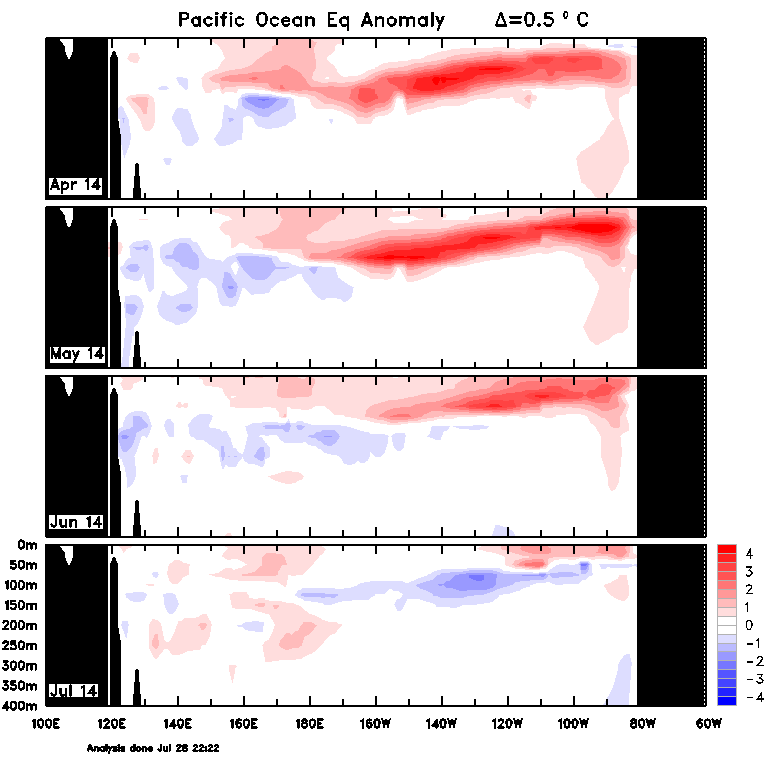Von Frank Bosse
Mitte Mai 2014 berichteten wir an dieser Stelle von den Entwicklungen im tropischen Pazifik und machten auf einen möglichen El Nino aufmerksam, unterließen jedoch die Verknüpfung mit Vokabel wie „wüten“, „Katastrophe“ und „Chaos“. Andere Medien waren offensiver:
Focus am 24. Februar 2014: Globales Klimaproblem: Sintflut, Hurrikan, Dürre – So hat El Niño gewütet
FAZ am 12. Mai 2014: Erwärmung und Wetterchaos: „El Nino“ ist im Anflug
Neue Zürcher Zeitung: «El Niño» könnte für Chaos sorgen
Und auch der eine oder andere Anhänger des Alarmismus hoffte auf die Wärme aus dem Meer, die den beobachteten Stillstand der globalen Temperaturen beenden könnte. Anfang Juni 2014 warnten wir bereits hier im Blog, dass die Wahrscheinlichkeit eines El Nino geringer war, als die Modelle dafür aussagten. Am 29. Juli 2014 konstatierte nun das Australische Meteorologische Institut auf seiner Webseite, dass die Wahrscheinlichkeit sehr stark zurückgegangen sei, dass sich zeitnah ein El Nino entwickeln könnte:
EL NINO INDICATORS EASE
Despite the tropical Pacific Ocean being primed for an El Niño during much of the first half of 2014, the atmosphere above has largely failed to respond, and hence the ocean and atmosphere have not reinforced each other. As a result, some cooling has now taken place in the central and eastern tropical Pacific Ocean, with most of the key NINO regions returning to neutral values. While the chance of an El Niño in 2014 has clearly eased, warmer-than-average waters persist in parts of the tropical Pacific, and the (slight) majority of climate models suggest El Niño remains likely for spring. Hence the establishment of El Niño before year’s end cannot be ruled out. If an El Niño were to occur, it is increasingly unlikely to be a strong event. Given the current observations and the climate model outlooks, the Bureau’s ENSO Tracker has shifted to El Niño WATCH status. This means the chance of El Niño developing in 2014 is approximately 50%, which remains significant at double the normal likelihood of an event. El Niño is often associated with wide scale below-average rainfall over southern and eastern inland areas of Australia and above-average daytime temperatures over southern Australia. Similar impacts prior to the event becoming fully established regularly occur. The Indian Ocean Dipole (IOD) index has been below −0.4 °C (the negative IOD threshold) since mid-June, but needs to remain negative into August to be considered an event. Model outlooks suggest this negative IOD is likely to be short lived, and return to neutral by spring. A negative IOD pattern typically brings wetter winter and spring conditions to inland and southern Australia.
Die „vermisste Wärme“ (da die Temperaturen seit etwa dem Beginn unseres Jahrtausends stillstehen und damit die Realität nicht mit den schönen Modellen harmoniert…) scheint wohl auch nicht im Wasser gewesen zu sein. Weitersuchen!

Abbildung: Der Ostpazifik kühlte in den letzten Monaten ab. Schlechte Nachrichten für den El Nino. Quelle: bom.gov.au
Bob Tisdale wies am 26. Juli 2014 im WUWT-Blog auf eine neue El Nino-freundliche Wärmeblase in tieferen Schichten hin, die offenbar nach Osten wandert...



